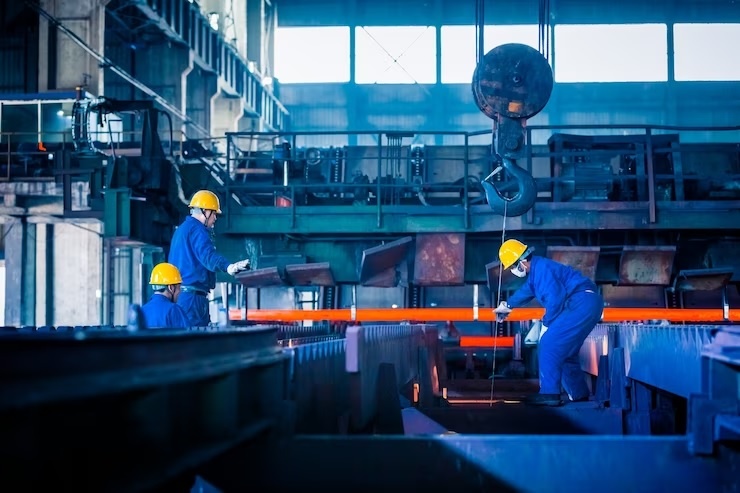Fostering industrial success through institutional growth
Vietnam’s industrial development has yet to overcome numerous obstacles. The industrial development rate has not fulfilled the requirements for accelerating the country’s industrialisation and modernisation, and the proportion of industry to GDP has not changed significantly over time.
 |
| Fostering industrial success through institutional growth, illustration photo/ Source: freepik.com |
Meanwhile, the pace of industrial restructuring remains sluggish and many development-prioritised industries fell short of their goals. The processing and manufacturing industry still operates primarily in the low segment of the value chain; the import rate of raw materials and fuel is still high; the production technology level is generally still low in comparison to the rest of the world; the model of specialised clusters and supporting industries has not yet been established; and the localisation rate is still low.
During the period of national renewal, Vietnam’s industry grew by leaps and bounds, making significant contributions to socioeconomic development achievements and enhancing the country’s potential and international standing. From 1986 to 2005, industrial production increased by 12.3 per cent, which is equivalent to 1.7 times the average growth rate of the 20 years preceding the renovation period.
In particular, in the previous decade, industry was the sector with the highest growth rate among the national economic sectors, contributed roughly 30 per cent to GDP, and became the principal export industry of Vietnam. This has helped Vietnam rise from rank 50 among the world’s largest exporting nations in 2010 to 22nd in 2019.
The industry’s internal capacity is still inadequate, with a heavy reliance on foreign-invested companies, and the sector’s capacity to transmit modern technology remains limited. Vietnam’s industry remains uncompetitive in comparison to other nations in the region and continent. With the exception of electronics, the majority of Vietnam’s industrial products have low levels of technology.
Currently, the capacity of the supporting industry cannot meet more than 10 per cent of the domestic demand for products that are primarily components and basic details with low value in the product value structure. Regional integration in industrial development remains ineffective. The current industrial development space is still separated by administrative boundaries, lacks cooperation and division of labour in the region, and lacks a reasonable distribution based on comparative advantage at the national level. Industrial growth is unrelated to other economic sectors, particularly agriculture.
The socioeconomic development strategy for 2021-2030 entails constructing a robust national industry and achieving a breakthrough in enhancing product productivity, quality, and competitiveness. Nonetheless, the aim of increasing the proportion of industry in GDP by 2030 is greater than 40 per cent; Vietnam’s processing and manufacturing industries’ added value per capita of more than $2,000 can only be attained when internal issues are resolved.
Vietnam must prioritise the improvement of industrial development institutions. Focus in particular must be on refining the state’s industrial development management mechanisms, ensuring stability, and encouraging production.
Implementing decentralisation to improve the efficacy of state management over the development process, and reviewing to modify and supplement technical regulations and norms in accordance with international industrial development standards, is also required.
Currently, it is crucial to improve the operational efficiency and competitiveness of industrial production enterprises; concurrently, to improve the quality of human resources for industrial development; and to enhance the labour market and employment services.
Another essential aspect is that Vietnam must improve its investment attraction to foster industrial growth. Completing the system of preferential and open policies associated with investment and promotion to entice capital in society and foreign investors to invest in industrial development. Meanwhile, it is crucial to encourage businesses to increase the size and scope of their investments. Inviting large and multinational corporations to invest in projects included on the list of national critical projects requiring overseas funding.
Thus, Vietnam must still develop a system of strategic solutions to create a fundamental shift in industrial development, thereby contributing to Vietnam becoming one of the industrial centres of the region as a member of the ASEAN-4 and the group of 30 nations with high average industrial competitiveness.
 | Institutional tweaks to open up EU investment Although Vietnam’s adoption of trade and investment agreements with the European Union are expected to be a boon for Vietnam, it triggers a need for the country to continue intensifying regulatory reforms – a key to help attract more investors and businesses from the EU. |
 | Institutional improvements to set stage for disbursement Disbursement of public investment since early this year remains slow. Minister of Planning and Investment Nguyen Chi Dung explained to VIR’s Nguyen Huong the reasons behind this situation, and proposed solutions to speed up progress. |
(*) Dr. Hoang Van Thanh - Mechanical Engineering Institute Vietnam Maritime University
What the stars mean:
★ Poor ★ ★ Promising ★★★ Good ★★★★ Very good ★★★★★ Exceptional
 Tag:
Tag:
Related Contents
Latest News
More News
- Main drivers for Vietnam’s digital economy future (December 03, 2025 | 11:35)
- Pivotal stage of growth paves way for rise in M&As (December 03, 2025 | 10:00)
- Positive projections for M&A interest from Thailand (December 03, 2025 | 09:40)
- Manifesting the first line of defence in cybersecurity (December 03, 2025 | 09:00)
- The transformational role AI can play in accounting arena (December 03, 2025 | 08:00)
- Unlocking 5G-AI potential in Singapore (December 03, 2025 | 08:00)
- Data-driven strategies vital for a fast-evolving nation (December 02, 2025 | 09:41)
- Policy to practice: how Vietnam can lead the region (November 26, 2025 | 16:03)
- Mobilising private capital at scale vital for climate battle (November 26, 2025 | 15:36)
- VILAF and Yoon & Yang launch Vietnam - Korea Practice Unit (November 26, 2025 | 15:16)






















 Mobile Version
Mobile Version